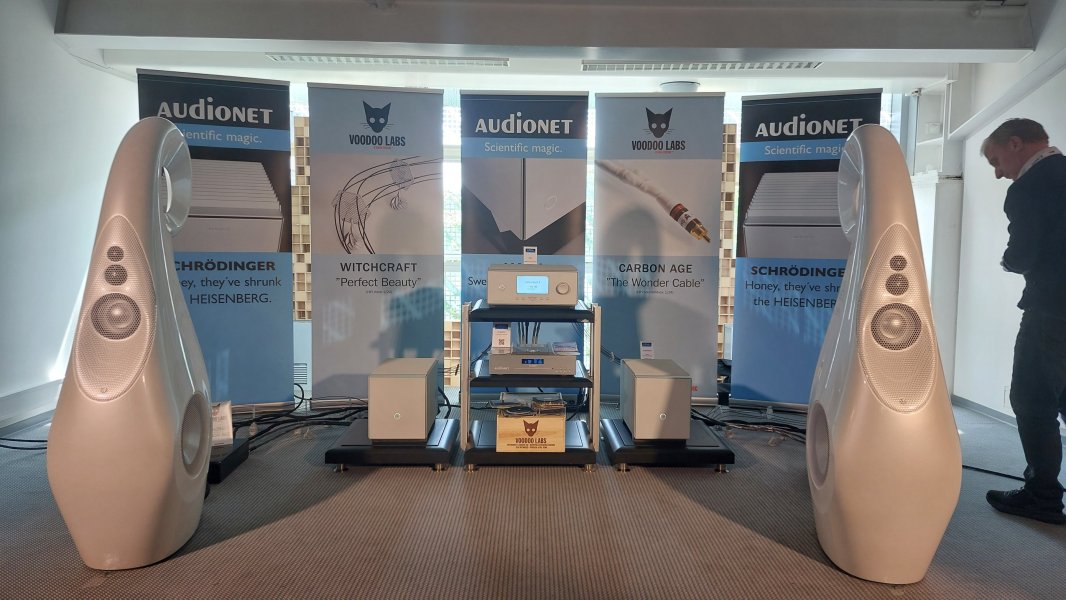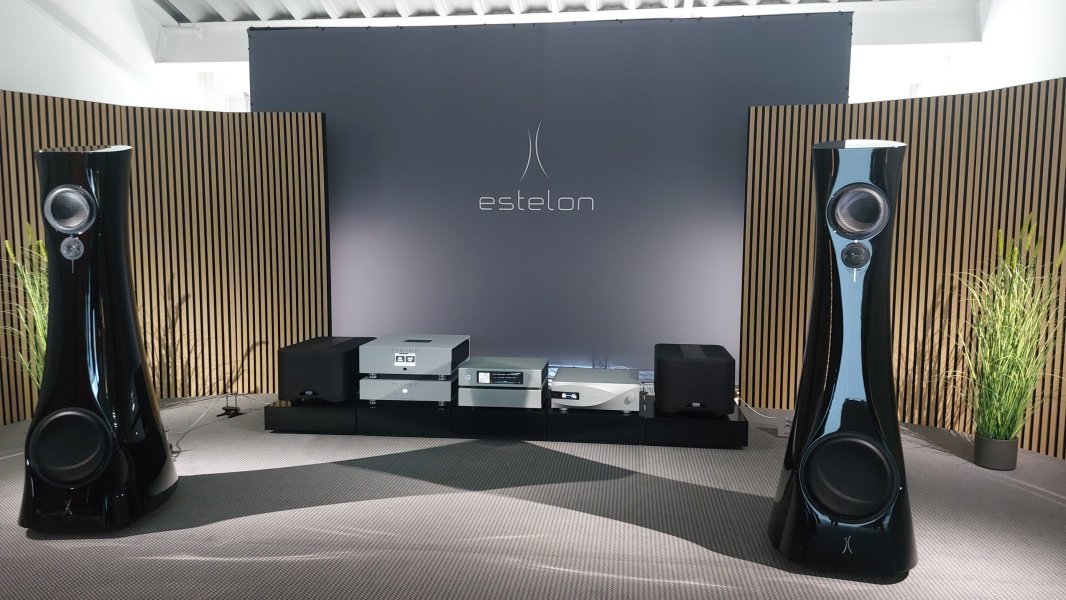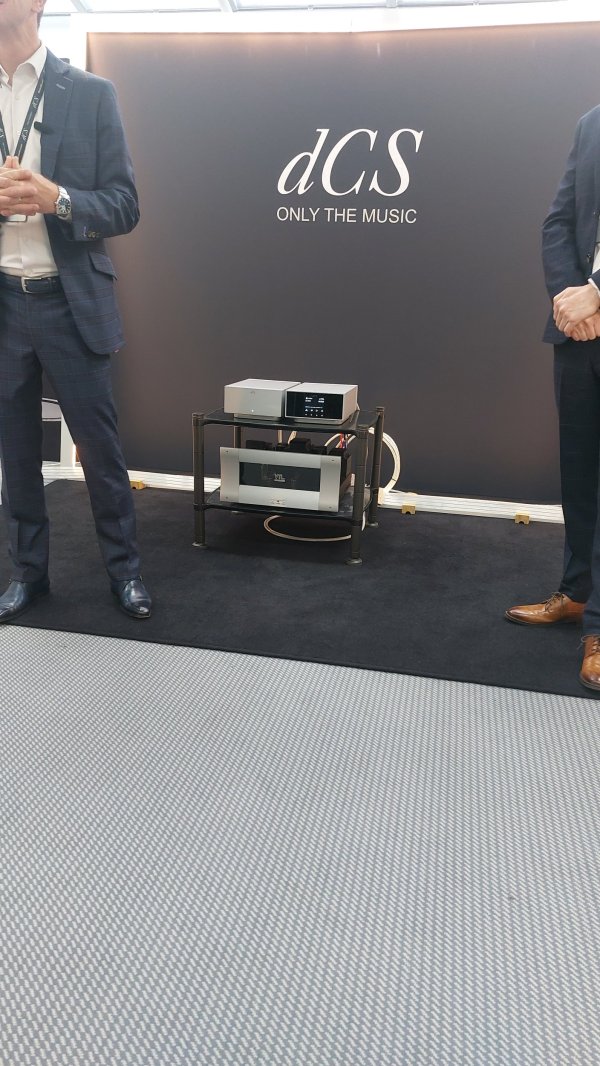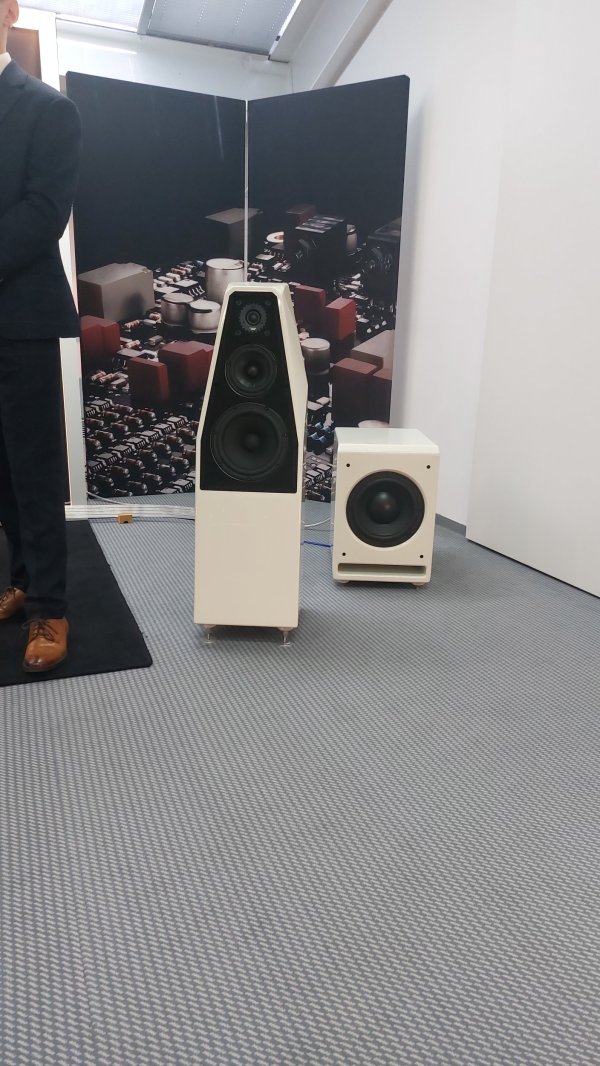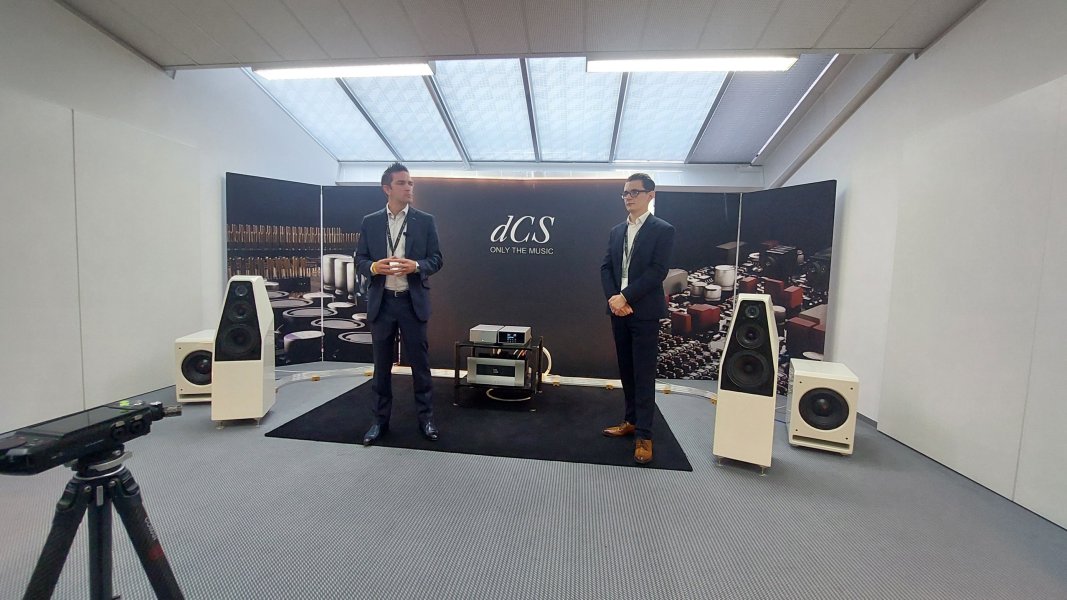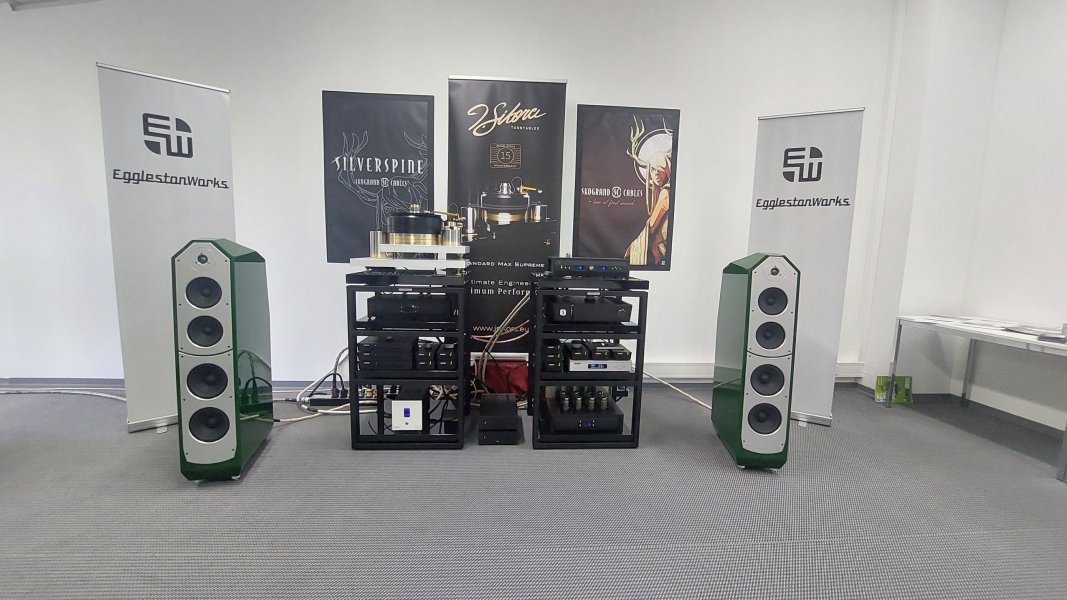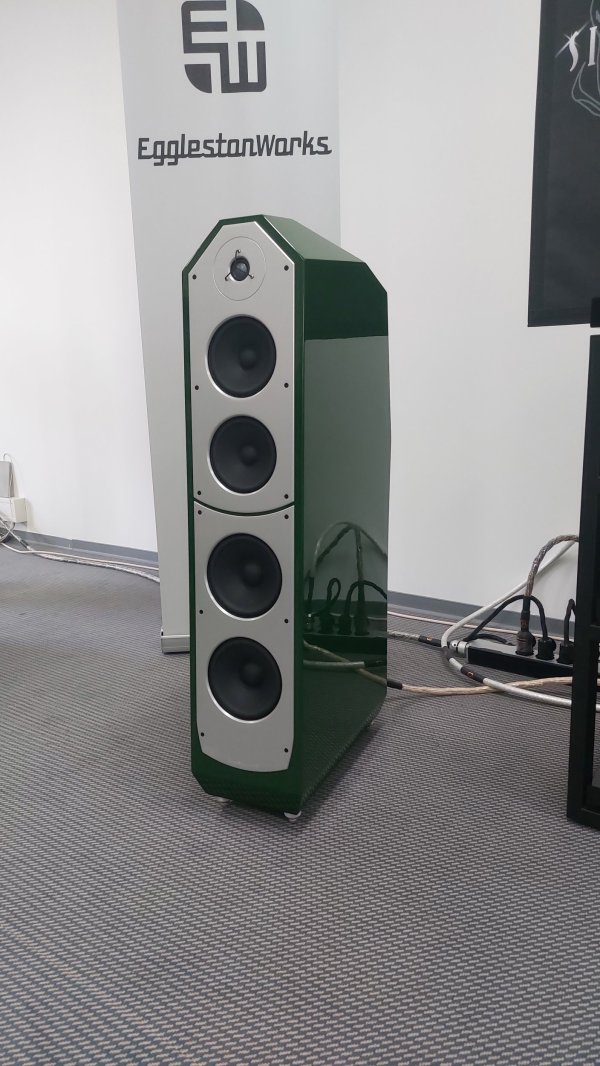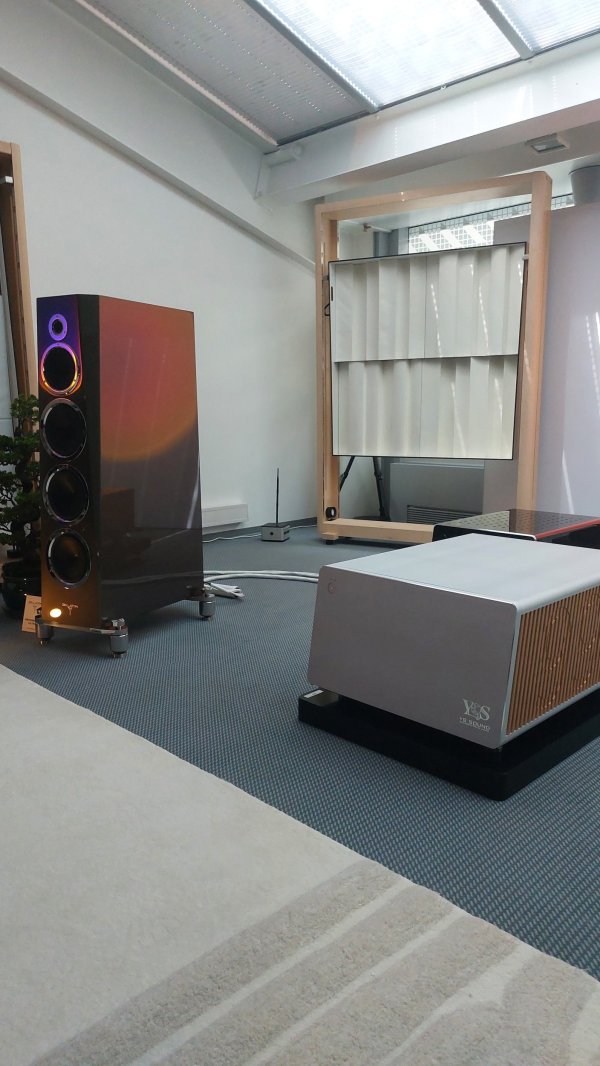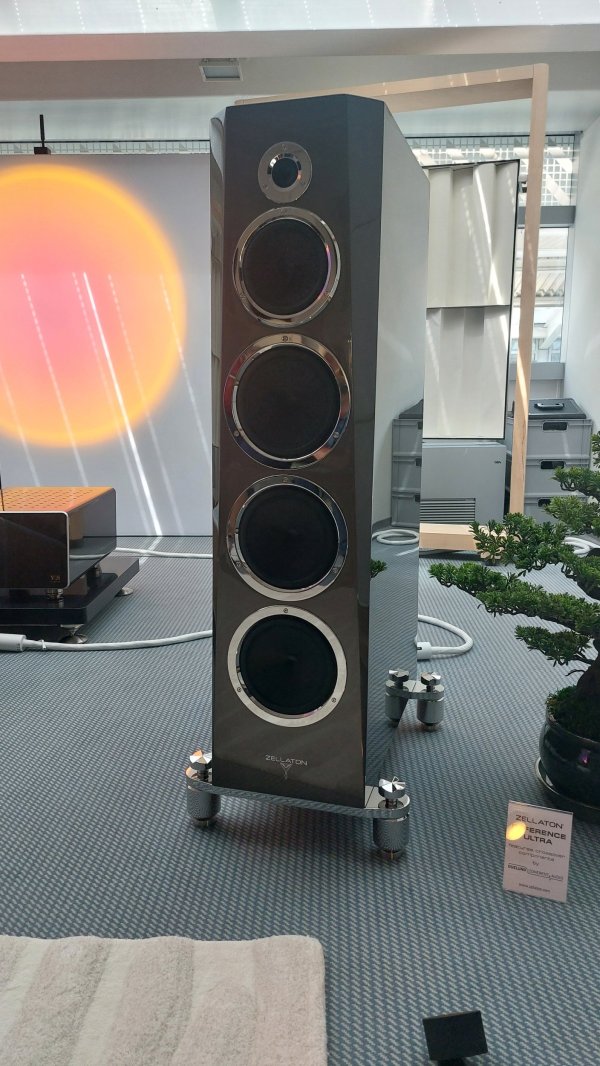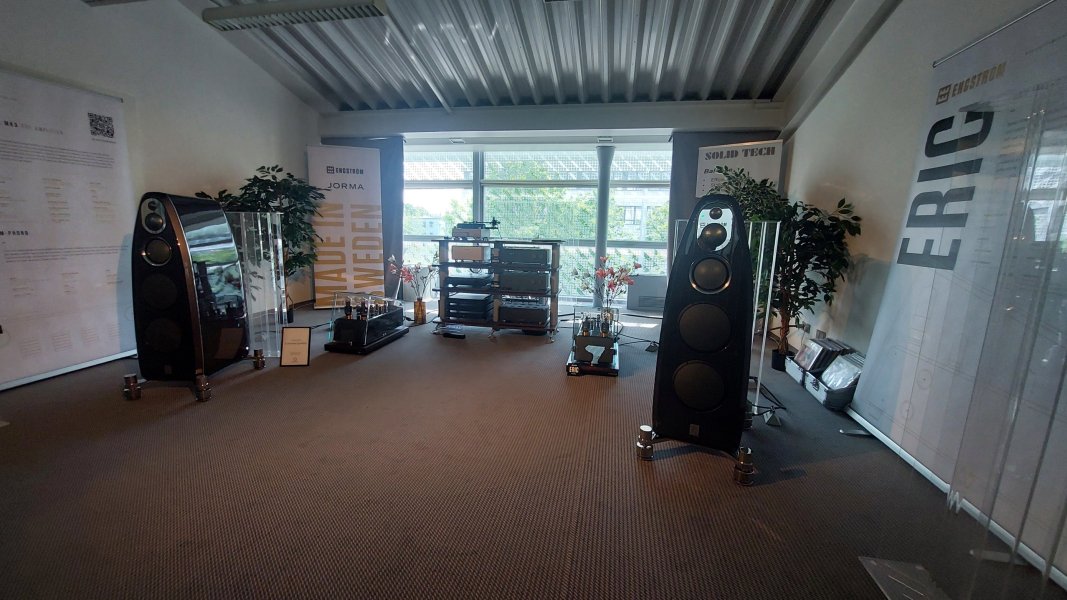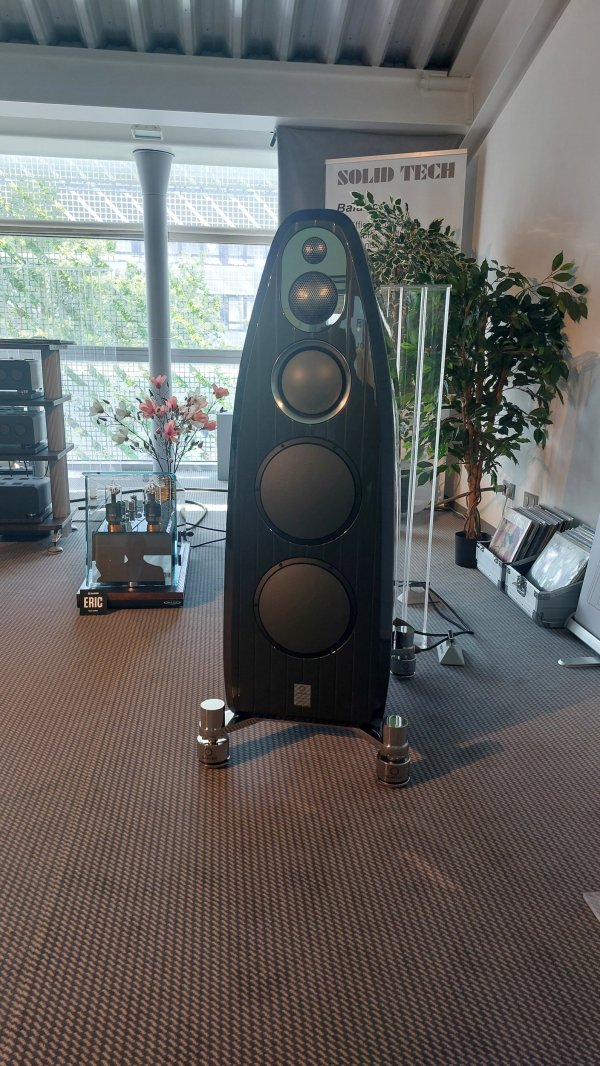Munich HighEnd 2024
- Thread starter redandgold
- Start date
You are using an out of date browser. It may not display this or other websites correctly.
You should upgrade or use an alternative browser.
You should upgrade or use an alternative browser.
this certainly doesn't look like $200k either.Yes, happily we get to make our choices.
We're being told here it is elegant and beautiful. Maybe it looks better in person. My first impression visually from the photo is of uber glossy paneled in plasticized wood.
View attachment 130657
Maybe he didn’t but I did side by side comparison of Kronos pro turntable.On the ride back from the Goebel factory, I had the misfortune of sitting behind and across from Louis Dejardins, the CEO of Kronos. For 30 minutes, this fellow pontficated to anyone within ear shot about why every other turntable made was inferior to his. Now, don’t get me wrong, It’s clear that Kronos makes a fine and highly regarded turntable. But this guy was a fountain of non-stop disparagement of every other turntable known to man. He trashed everything including the American Sound, to the highly revered minus K system employed in the Dohmann Helix. But I noticed one key similarity to his diatribes, which were that he never admitted to doing side by side comparisons of any of them to his own
First comparison was against Techdas AF3P and the difference was huge. Second comparison was against DaVinci turntable. Again the difference was huge. I’m not a fan of DaVinci turntables in particular but Kronos pro sounded like ungrounded, rushed and low in separation just like a budget Project turntable IMHO. That’s the best I can do to describe it. Additionally I don’t know if it’s possible to stand it’s motor noise. I know everyone will say that “my Kronos is dead quiet” but I heard 3 or 4 Kronos turntables and each of them had motor noise.
I heard Dőhmann Helix, Esoteric turntable and tried minus K under the turntable. I have a clear idea how Kronos would perform against them but anyhow all I can say is I hope the new Kronos Discovery is better than pro.
Last edited:
Excellent reporting Marty! Some of the best insight I have ever gotten from Munich...Thank You for taking the time to share with all of us...Departing thoughts. These are mostly conversations with various people at MOC.
Western Electric. I had a brief conversation with Charles Whitener, the CEO. I asked him if the much rumored re-issue of the famed 274B was in the works. He said absolutely not. He said they would only sell about 100 a year and for him, that’s a non-starter. He said he’s only interested in making tubes that he can sell in quantities of 10,000. The good news is that they are releasing re-issues of 3 small tubes by the end of the year, basically the trifecta of 12AT7 (ECC81), 12AU7 (ECC82), and 12AX7 (ECC83).
I passed by the WBT display and asked if they were ever going to make XLR connectors. He said that they considered it and decided that the tool and die acquisition for these connectors were simply not worth the cost. Too bad.
On the way to the Goebel factory on Thursday evening, the buss was full except for the seat next to me. Oliver Goebel apparently drew the short straw and had to sit next to me for the 30 minute trip. We had a wonderful conversation. He was so open and transparent about everything I inquired about. We discussed crossover design, phase linearity (both electrical and acoustic), time alignment, the minimization of cabinet resonances (he spent years designing his ported woofer cabinets chambers for perfect resonance symmetry both left and right of the driver as well as top and bottom), driver materials (he eschews foam surrounds and prefers coated paper drivers with very specific requirements for each driver) and a bunch of other esoteric stuff that only an audio nerd could love. I was impressed that he told me their QC involves tweaking every speaker’s crossover individually to perfectly match speaker pairs since not only are parts, even with 1% tolerance, not “good enough” but there is variability in the electrical properties of individual drivers that need to be accounted for as well with minor individual bench adjustments before the speakers are released. In fact, that's exactly what John Dunlavy used to do and he showed me exactly how to do it on his bench! In fact, the last time I had a conversation with a speaker designer this willing to divulge his secrets, was when I visited the Dunlavy factory decades ago and had a similar conversation with John Dunlavy. The main difference was that Oliver was sober. Oliver’s desire to achieve perfection, his wisdom and engineering chops impressed me when he said the same words that I remember Dunlavy saying, namely that everything in audio design is an engineering tradeoff. That sort of modesty was very refreshing and very different from my next conversation.
On the ride back from the Goebel factory, I had the misfortune of sitting behind and across from Louis Dejardins, the CEO of Kronos. For 30 minutes, this fellow pontficated to anyone within ear shot about why every other turntable made was inferior to his. Now, don’t get me wrong, It’s clear that Kronos makes a fine and highly regarded turntable. But this guy was a fountain of non-stop disparagement of every other turntable known to man. He trashed everything including the American Sound, to the highly revered minus K system employed in the Dohmann Helix. But I noticed one key similarity to his diatribes, which were that he never admitted to doing side by side comparisons of any of them to his own. I quietly continued listened as he trashed the Esoteric table. He said it was a bad sounding table because “it's all made out of one metal, namely aluminum, and that could not possibly be good”. According to Louis, the only correct way to make a table is to use many metals (his use 40-50 metals) since every metal has a different resonance whereas the use of a single metal such as aluminum will have a serious resonance of a single metal, which he thinks is pernicious. I was thinking to myself, “hmmm, are there even 50 metals in the periodic table of elements that can be used to fashion the metal parts he claims to use?” I thought I would ask him that but kept quiet. But I decided to enter the fray after a few more comments on his part about why the Esoteric was a bad table. The conversation went something like this:
“Excuse me, but may I ask if your assessment of the Esoteric was based on a side by side comparison? And if so, can you be certain the differences you heard were due to the table, or could it have been to differences in the arm or cartridge if indeed they were different”. And if so, how can you tell them apart? His reply stunned me.
“If you understand the properties of material sciences and design, you don’t really need to do the comparison”
“So did you do any control experiments that might be useful in reaching your conclusion or was it based solely on your understanding of material science?”
To paraphrase, he basically said “Yes. I don’t need to do any control experiments”
Now I’m thinking, I know of only one example where the need for a control experiment might not be required. It was on Star Trek when Spock said “If I hold a object over my should and release it, on a planet with positive gravity, I don’t need to see it to know that it will fall to the ground”. But trust me, this guy is no Spock. He is a highly opinionated, self-deluded manufacturer who happens to make a fine turntable.
At this point, I decided to withdraw from the conversation. This is the sort of sophistry in high end audio that is both unattractive and unneccesary and for which I have little patience. Looks like I was the one who drew the short straw on the bus ride back from the Goebel factory.
Let’s contrast that conversation with the one I had with Daryl Wilson. We began when I told him about my first show about 40 years ago where his dad displayed the WATTs using Rowland Research model 7s. When I went to his booth on Sunday, I noticed it was closed. I told him that my admiration for his dad only increased from that day forward. Now remember, Dave Wilson and Wilson audio was barely known at that time. Show traffic could mean significant sales for a nascent company. But what Dave did was pull a Chick-Fil-A way head of its time by chosing to honor his faith rather than his commercial interest. It was easy to see the look of appreciation on Daryl’s face. We then discussed some specific audio trivia. I then told him that part of the reason I bought my speakers was the confidence in the methods he and his dad used to evaluate certain crossover parts by changing them using long runs of wire where they could change components immediately at the listening position. He smiled and said it’s the only way to do it. I agreed, having done the same thing for years when I was a DIY’er.
I then told him that my one concern about my system was that it takes time to sound its best (about 90 minutes, and this has occurred despite several gear changes over the years). I asked whether this could be due to the time it takes for the voice coil and/or some crossover elements to come to some sort of a thermal equilibrium which ultimately would allow for ultimate performance. Here was his reply:
“Well, I’d have to do a controlled experiment with one fully warned up system placed side by side to a “cold” system to see if there is a sonic difference”. Wow. My kind of guy. And very different from the reply I got from the gentleman at Kronos.
That’s a wrap. I doubt I will ever go to the Munich show again. As I mentioned, it was more of a bucket list item than anything else. With so many good audio shows that are far closer to home, my sense is that there is really no need to do so if your goal is to hear a lot of the world’s finest gear. But it was nevertheless, very enjoyable and a good opportunity to get some time with many audio luminaries and friends. (Of course, the highlight of my EU trip was hearing Beethoven's 9th with the Vienna Phil in Vienna last Monday post #969 https://www.whatsbestforum.com/threads/recent-concerts-youve-enjoyed.3840/page-49#post-967010).
The bigger version .
I like the small clarysis may be even more
Many have said the same ...!
I don't think I would really concur with that view long term with both pairs to compare in my own room over a long period of time.
The Piccolo requires a low seating position to get the best out of it, no question IMHO.
What is interesting about the Piccolo is that bass panel shape works, or at least appears to from what I heard.
Easy fix , stands like we did with apogee stages..
My understanding is that Clarisys is working on platforms for the Picolos.Easy fix , stands like we did with apogee stages..
Thanks for sharing you’re experience and thoughts. Good story telling. As you’re conversation with kronos guy illustrates:Departing thoughts. These are mostly conversations with various people at MOC.
Western Electric. I had a brief conversation with Charles Whitener, the CEO. I asked him if the much rumored re-issue of the famed 274B was in the works. He said absolutely not. He said they would only sell about 100 a year and for him, that’s a non-starter. He said he’s only interested in making tubes that he can sell in quantities of 10,000. The good news is that they are releasing re-issues of 3 small tubes by the end of the year, basically the trifecta of 12AT7 (ECC81), 12AU7 (ECC82), and 12AX7 (ECC83).
I passed by the WBT display and asked if they were ever going to make XLR connectors. He said that they considered it and decided that the tool and die acquisition for these connectors were simply not worth the cost. Too bad.
On the way to the Goebel factory on Thursday evening, the buss was full except for the seat next to me. Oliver Goebel apparently drew the short straw and had to sit next to me for the 30 minute trip. We had a wonderful conversation. He was so open and transparent about everything I inquired about. We discussed crossover design, phase linearity (both electrical and acoustic), time alignment, the minimization of cabinet resonances (he spent years designing his ported woofer cabinets chambers for perfect resonance symmetry both left and right of the driver as well as top and bottom), driver materials (he eschews foam surrounds and prefers coated paper drivers with very specific requirements for each driver) and a bunch of other esoteric stuff that only an audio nerd could love. I was impressed that he told me their QC involves tweaking every speaker’s crossover individually to perfectly match speaker pairs since not only are parts, even with 1% tolerance, not “good enough” but there is variability in the electrical properties of individual drivers that need to be accounted for as well with minor individual bench adjustments before the speakers are released. In fact, that's exactly what John Dunlavy used to do and he showed me exactly how to do it on his bench! In fact, the last time I had a conversation with a speaker designer this willing to divulge his secrets, was when I visited the Dunlavy factory decades ago and had a similar conversation with John Dunlavy. The main difference was that Oliver was sober. Oliver’s desire to achieve perfection, his wisdom and engineering chops impressed me when he said the same words that I remember Dunlavy saying, namely that everything in audio design is an engineering tradeoff. That sort of modesty was very refreshing and very different from my next conversation.
On the ride back from the Goebel factory, I had the misfortune of sitting behind and across from Louis Dejardins, the CEO of Kronos. For 30 minutes, this fellow pontficated to anyone within ear shot about why every other turntable made was inferior to his. Now, don’t get me wrong, It’s clear that Kronos makes a fine and highly regarded turntable. But this guy was a fountain of non-stop disparagement of every other turntable known to man. He trashed everything including the American Sound, to the highly revered minus K system employed in the Dohmann Helix. But I noticed one key similarity to his diatribes, which were that he never admitted to doing side by side comparisons of any of them to his own. I quietly continued listened as he trashed the Esoteric table. He said it was a bad sounding table because “it's all made out of one metal, namely aluminum, and that could not possibly be good”. According to Louis, the only correct way to make a table is to use many metals (his use 40-50 metals) since every metal has a different resonance whereas the use of a single metal such as aluminum will have a serious resonance of a single metal, which he thinks is pernicious. I was thinking to myself, “hmmm, are there even 50 metals in the periodic table of elements that can be used to fashion the metal parts he claims to use?” I thought I would ask him that but kept quiet. But I decided to enter the fray after a few more comments on his part about why the Esoteric was a bad table. The conversation went something like this:
“Excuse me, but may I ask if your assessment of the Esoteric was based on a side by side comparison? And if so, can you be certain the differences you heard were due to the table, or could it have been to differences in the arm or cartridge if indeed they were different”. And if so, how can you tell them apart? His reply stunned me.
“If you understand the properties of material sciences and design, you don’t really need to do the comparison”
“So did you do any control experiments that might be useful in reaching your conclusion or was it based solely on your understanding of material science?”
To paraphrase, he basically said “Yes. I don’t need to do any control experiments”
Now I’m thinking, I know of only one example where the need for a control experiment might not be required. It was on Star Trek when Spock said “If I hold a object over my should and release it, on a planet with positive gravity, I don’t need to see it to know that it will fall to the ground”. But trust me, this guy is no Spock. He is a highly opinionated, self-deluded manufacturer who happens to make a fine turntable.
At this point, I decided to withdraw from the conversation. This is the sort of sophistry in high end audio that is both unattractive and unneccesary and for which I have little patience. Looks like I was the one who drew the short straw on the bus ride back from the Goebel factory.
Let’s contrast that conversation with the one I had with Daryl Wilson. We began when I told him about my first show about 40 years ago where his dad displayed the WATTs using Rowland Research model 7s. When I went to his booth on Sunday, I noticed it was closed. I told him that my admiration for his dad only increased from that day forward. Now remember, Dave Wilson and Wilson audio was barely known at that time. Show traffic could mean significant sales for a nascent company. But what Dave did was pull a Chick-Fil-A way head of its time by chosing to honor his faith rather than his commercial interest. It was easy to see the look of appreciation on Daryl’s face. We then discussed some specific audio trivia. I then told him that part of the reason I bought my speakers was the confidence in the methods he and his dad used to evaluate certain crossover parts by changing them using long runs of wire where they could change components immediately at the listening position. He smiled and said it’s the only way to do it. I agreed, having done the same thing for years when I was a DIY’er.
I then told him that my one concern about my system was that it takes time to sound its best (about 90 minutes, and this has occurred despite several gear changes over the years). I asked whether this could be due to the time it takes for the voice coil and/or some crossover elements to come to some sort of a thermal equilibrium which ultimately would allow for ultimate performance. Here was his reply:
“Well, I’d have to do a controlled experiment with one fully warned up system placed side by side to a “cold” system to see if there is a sonic difference”. Wow. My kind of guy. And very different from the reply I got from the gentleman at Kronos.
That’s a wrap. I doubt I will ever go to the Munich show again. As I mentioned, it was more of a bucket list item than anything else. With so many good audio shows that are far closer to home, my sense is that there is really no need to do so if your goal is to hear a lot of the world’s finest gear. But it was nevertheless, very enjoyable and a good opportunity to get some time with many audio luminaries and friends. (Of course, the highlight of my EU trip was hearing Beethoven's 9th with the Vienna Phil in Vienna last Monday post #969 https://www.whatsbestforum.com/threads/recent-concerts-youve-enjoyed.3840/page-49#post-967010).
Intelligence (-) Humility = Blind Arrogance.
Or dump on subwoofers as per Stage.Easy fix , stands like we did with apogee stages..
so much for this, or any hi fi show NOT being for mostly the middle age to older men, just look at the second picture of show's opening...hahahaha
You will feel differently after leaving Daycare ..!
Isn't this rhe one Jays Audio did a long video on. It seemed great.Absolutely enourmous amp .
Zelllaton YS sound
Um, thanks for reminding me. I’ll see if I can’t get my foot out of my mouth but its in pretty deep!Yes, happily we get to make our choices.
We're being told here it is elegant and beautiful. Maybe it looks better in person. My first impression visually from the photo is of uber glossy paneled in plasticized wood.
View attachment 130657
As far as the Klingon Holodeck goes, we can always blame the Romulans ...
View attachment 130658

In the right environment there is room for Romulans I suppose. But Klingons? There does seem to be a holodeck gestalt in some corners of the hobby, e.g. WADAX and not only a few others.

Departing thoughts. These are mostly conversations with various people at MOC.
Western Electric. I had a brief conversation with Charles Whitener, the CEO. I asked him if the much rumored re-issue of the famed 274B was in the works. He said absolutely not. He said they would only sell about 100 a year and for him, that’s a non-starter. He said he’s only interested in making tubes that he can sell in quantities of 10,000. The good news is that they are releasing re-issues of 3 small tubes by the end of the year, basically the trifecta of 12AT7 (ECC81), 12AU7 (ECC82), and 12AX7 (ECC83).
I passed by the WBT display and asked if they were ever going to make XLR connectors. He said that they considered it and decided that the tool and die acquisition for these connectors were simply not worth the cost. Too bad.
On the way to the Goebel factory on Thursday evening, the buss was full except for the seat next to me. Oliver Goebel apparently drew the short straw and had to sit next to me for the 30 minute trip. We had a wonderful conversation. He was so open and transparent about everything I inquired about. We discussed crossover design, phase linearity (both electrical and acoustic), time alignment, the minimization of cabinet resonances (he spent years designing his ported woofer cabinets chambers for perfect resonance symmetry both left and right of the driver as well as top and bottom), driver materials (he eschews foam surrounds and prefers coated paper drivers with very specific requirements for each driver) and a bunch of other esoteric stuff that only an audio nerd could love. I was impressed that he told me their QC involves tweaking every speaker’s crossover individually to perfectly match speaker pairs since not only are parts, even with 1% tolerance, not “good enough” but there is variability in the electrical properties of individual drivers that need to be accounted for as well with minor individual bench adjustments before the speakers are released. In fact, that's exactly what John Dunlavy used to do and he showed me exactly how he did it on his bench! The last time I had a conversation with a speaker designer this willing to divulge his secrets, was when I visited the Dunlavy factory decades ago and had a similar conversation with John Dunlavy. The main difference was that Oliver was sober. Oliver’s desire to achieve perfection, his wisdom and engineering chops impressed me when he said the same words that I remember Dunlavy saying, namely that everything in audio design is an engineering tradeoff. That sort of modesty was very refreshing and very different from my next conversation.
On the ride back from the Goebel factory, I had the misfortune of sitting behind and across from Louis Dejardins, the CEO of Kronos. For 30 minutes, this fellow pontficated to anyone within ear shot about why every other turntable made was inferior to his. Now, don’t get me wrong, It’s clear that Kronos makes a fine and highly regarded turntable. But this guy was a fountain of non-stop disparagement of every other turntable known to man. He trashed everything including the American Sound, to the highly revered minus K system employed in the Dohmann Helix. But I noticed one key similarity to his diatribes, which were that he never admitted to doing side by side comparisons of any of them to his own. I quietly continued listened as he trashed the Esoteric table. He said it was a bad sounding table because “it's all made out of one metal, namely aluminum, and that could not possibly be good”. According to Louis, the only correct way to make a table is to use many metals (his use 40-50 metals) since every metal has a different resonance whereas the use of a single metal such as aluminum will have a serious resonance of a single metal, which he thinks is pernicious. I was thinking to myself, “hmmm, are there even 50 metals in the periodic table of elements that can be used to fashion the metal parts he claims to use?” I thought I would ask him that but kept quiet. But I decided to enter the fray after a few more comments on his part about why the Esoteric was a bad table. The conversation went something like this:
“Excuse me, but may I ask if your assessment of the Esoteric was based on a side by side comparison? And if so, can you be certain the differences you heard were due to the table, or could it have been to differences in the arm or cartridge if indeed they were different”. And if so, how can you tell them apart? His reply stunned me.
“If you understand the properties of material sciences and design, you don’t really need to do the comparison”
“So did you do any control experiments that might be useful in reaching your conclusion or was it based solely on your understanding of material science?”
To paraphrase, he basically said “Yes. I don’t need to do any control experiments”
Now I’m thinking, I know of only one example where the need for a control experiment might not be required. It was on Star Trek when Spock said “If I hold a object over my should and release it, on a planet with positive gravity, I don’t need to see it to know that it will fall to the ground”. But trust me, this guy is no Spock. He is a highly opinionated, self-deluded manufacturer who happens to make a fine turntable.
At this point, I decided to withdraw from the conversation. This is the sort of sophistry in high end audio that is both unattractive and unneccesary and for which I have little patience. Looks like I was the one who drew the short straw on the bus ride back from the Goebel factory.
Let’s contrast that conversation with the one I had with Daryl Wilson. We began when I told him about my first show about 40 years ago where his dad displayed the WATTs using Rowland Research model 7s. When I went to his booth on Sunday, I noticed it was closed. I told him that my admiration for his dad only increased from that day forward. Now remember, Dave Wilson and Wilson audio was barely known at that time. Show traffic could mean significant sales for a nascent company. But what Dave did was pull a Chick-Fil-A way head of its time by chosing to honor his faith rather than his commercial interest. It was easy to see the look of appreciation on Daryl’s face. We then discussed some specific audio trivia. I then told him that part of the reason I bought my speakers was the confidence in the methods he and his dad used to evaluate certain crossover parts by changing them using long runs of wire where they could change components immediately at the listening position. He smiled and said it’s the only way to do it. I agreed, having done the same thing for years when I was a DIY’er.
I then told him that my one concern about my system was that it takes time to sound its best (about 90 minutes, and this has occurred despite several gear changes over the years). I asked whether this could be due to the time it takes for the voice coil and/or some crossover elements to come to some sort of a thermal equilibrium which ultimately would allow for ultimate performance. Here was his reply:
“Well, I’d have to do a controlled experiment with one fully warned up system placed side by side to a “cold” system to see if there is a sonic difference”. Wow. My kind of guy. And very different from the reply I got from the gentleman at Kronos.
That’s a wrap. I doubt I will ever go to the Munich show again. As I mentioned, it was more of a bucket list item than anything else. With so many good audio shows that are far closer to home, my sense is that there is really no need to do so if your goal is to hear a lot of the world’s finest gear. But it was nevertheless, very enjoyable and a good opportunity to get some time with many audio luminaries and friends. (Of course, the highlight of my EU trip was hearing Beethoven's 9th with the Vienna Phil in Vienna last Monday post #969 https://www.whatsbestforum.com/threads/recent-concerts-youve-enjoyed.3840/page-49#post-967010).
Great Stuff Marty, My 2cents , never heard a kronos table that was worthy , i now understand why..
The lack of side by side compares is obvious to save the embarrassment ..!
Regards
so much for this, or any hi fi show NOT being for mostly the middle age to older men, just look at the second picture of show's opening...hahahaha
Young folks are eager to make a career in audio industry after seeing all the prices
I think you did well to stay at home. This year is disappointing. Literally nothing made me think WOW.Young folks are eager to make a career in audio industry after seeing all the prices
Similar threads
- Replies
- 12
- Views
- 2K
- Replies
- 13
- Views
- 3K
- Replies
- 12
- Views
- 3K
- Replies
- 4
- Views
- 1K


